Hemocytometer how to use - Study guides, Class notes & Summaries
Looking for the best study guides, study notes and summaries about Hemocytometer how to use? On this page you'll find 25 study documents about Hemocytometer how to use.
Page 3 out of 25 results
Sort by
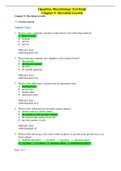
-
OpenStax Microbiology Test Bank Chapter 9: Microbial Growth A+
- Exam (elaborations) • 17 pages • 2021
-
- $10.49
- + learn more
OpenStax Microbiology Test Bank Chapter 9: Microbial Growth Page 1 of 17 Chapter 9: Microbial Growth * = Correct answer Multiple Choice 1. Bacteria most commonly reproduce using which of the following methods? A. binary fission* B. budding C. meiosis D. mitosis Difficulty: Easy ASM Standard: N/A 2. Which structure separates new daughter cells in binary fission? A. the crescent B. the division septum* C. the FtsZ D. the spindle apparatus Difficulty: Easy ASM Standard: N/A 3. W...
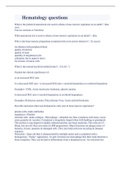
-
Hematology questions with accurate answers 100%
- Exam (elaborations) • 26 pages • 2023
-
Available in package deal
-
- $13.49
- + learn more
Hematology questions What is the preferred anatomical site used to obtain a bone marrow aspiration on an adult? - Iliac crest Can use sternum or Vertebrae What anatomical site is used to obtain a bone marrow aspiration on an infant? - tibia Why is the bone marrow preparation examined with a low power objective? - To assess: for dilution with peripheral blood quality of marrow quality of stain quantity of megakaryocytes cellularity (fat to marrow ratio) for clusters of tumor ...
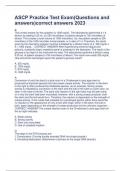
-
ASCP Practice Test Exam(Questions and answers)correct answers 2023
- Exam (elaborations) • 30 pages • 2023
-
Available in package deal
-
- $13.49
- + learn more
ASCP Practice Test Exam(Questions and answers)correct answers 2023 B; The correct answer for this question is 1300 mg/dL. The laboratorian performed a 1:4 dilution by adding 0.25 mL (or 250 microliters) of patient sample to 750 microliters of diluent. This creates a total volume of 1000 microliters. So, the patient sample is 250 microliters of the 1000 microliter mixed sample, or a ratio of 1:4. Therefore, the result given by the chemistry analyzer must be multiplied by a dilution fa...
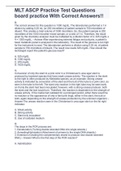
-
MLT ASCP Practice Test Questions board practice With Correct Answers!!
- Exam (elaborations) • 31 pages • 2022
-
- $20.49
- + learn more
B; The correct answer for this question is 1300 mg/dL. The laboratorian performed a 1:4 dilution by adding 0.25 mL (or 250 microliters) of patient sample to 750 microliters of diluent. This creates a total volume of 1000 microliters. So, the patient sample is 250 microliters of the 1000 microliter mixed sample, or a ratio of 1:4. Therefore, the result given by the chemistry analyzer must be multiplied by a dilution factor of 4. 325 mg/dL x 4 = 1300 mg/dL. After experiencing extreme fatigue and...
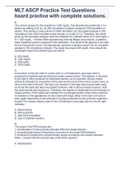
-
MLT ASCP Practice Test Questions board practice with complete solutions.
- Exam (elaborations) • 31 pages • 2022
-
- $20.99
- + learn more
B; The correct answer for this question is 1300 mg/dL. The laboratorian performed a 1:4 dilution by adding 0.25 mL (or 250 microliters) of patient sample to 750 microliters of diluent. This creates a total volume of 1000 microliters. So, the patient sample is 250 microliters of the 1000 microliter mixed sample, or a ratio of 1:4. Therefore, the result given by the chemistry analyzer must be multiplied by a dilution factor of 4. 325 mg/dL x 4 = 1300 mg/dL. After experiencing extreme fatigue and...

Do you wonder why so many students wear nice clothes, have money to spare and enjoy tons of free time? Well, they sell on Stuvia! Imagine your study notes being downloaded a dozen times for $15 each. Every. Single. Day. Discover all about earning on Stuvia


